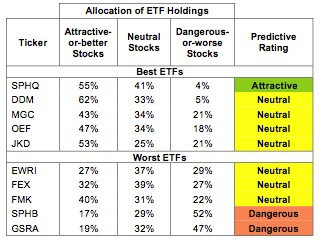The large-cap blend style ranks first out of the twelve fund styles as detailed in my Style Rankings for ETFs and Mutual Funds report. It gets my Neutral rating, which is based on aggregation of ratings of 33 ETFs and 944 mutual funds in the large-cap blend style as of February 1st, 2013. Prior reports on the best & worst ETFs and mutual funds in every sector and style are here.
Figures 1 and 2 show the five best and worst-rated ETFs and mutual funds in the style. Not all large-cap blend style ETFs and mutual funds are created the same. The number of holdings varies widely (from 18 to 992), which creates drastically different investment implications and ratings. The best ETFs and mutual funds allocate more value to Attractive-or-better-rated stocks than the worst, which allocate too much value to Neutral-or-worse-rated stocks.
To identify the best and avoid the worst ETFs and mutual funds within the large-cap blend style, investors need a predictive rating based on (1) stocks ratings of the holdings and (2) the all-in expenses of each ETF and mutual fund. Investors need not rely on backward-looking ratings. My fund rating methodology is detailed here.
Investors seeking exposure to the large-cap blend style should buy one of the Attractive-or-better rated ETFs or mutual funds from Figures 1 and 2.
Get my ratings on all ETFs and mutual funds in this style on my free mutual fund and ETF screener.
Figure 1: ETFs with the Best & Worst Ratings – Top 5

Sources: New Constructs, LLC and company filings
ProShares UltraPro Dow30 (UDOW) and iShares Russell Top 200 Index Fund (IWL) are excluded from Figure 1 because their total net assets (TNA) are below $100 million and do not meet our liquidity standards.
Figure 2: Mutual Funds with the Best & Worst Ratings – Top 5

Sources: New Constructs, LLC and company filings
Pear Tree Funds: Pear Tree Quality Fund (QGIAX, USBOX) is excluded from Figure 2 because its total net assets (TNA) are below $100 million and do not meet our liquidity standards.
PowerShares S&P 500 High Quality Portfolio (SPHQ) is my top-rated large-cap blend ETF and earns my Attractive rating. GMO Trust: GMO Quality Fund (GQLOX) is my top-rated large-cap blend mutual fund and earns my Very Attractive rating.
ALPS ALPS/GS Risk-Adjusted Return U.S. Large Cap Index ETF (GSRA) is my worst-rated large-cap blend ETF and Cavanal Hill Funds: Cavanal Hill Opportunistic Fund (AAOPX) is my worst-rated large-cap blend mutual fund. Both earn my Dangerous rating.
Figure 3 shows that 402 out of the 1572 stocks (over 46% of the market value) in large-cap blend ETFs and mutual funds get an Attractive-or-better rating. However, only one of the 33 large-cap blend ETFs (less than 1% of total net assets) and 68 out of 944 large-cap blend mutual funds (less than 10% of total net assets) get an Attractive-or-better rating.
The takeaways are: mutual fund managers allocate too much capital to low-quality stocks and large-cap blend ETFs hold poor quality stocks.
Figure 3: Large-cap Blend Style Landscape For ETFs, Mutual Funds & Stocks

As detailed in “Cheap Funds Dupe Investors”, the fund industry offers many cheap funds but very few funds with high-quality stocks, or with what I call good portfolio management.
Investors need to tread carefully when considering large-cap blend ETFs and mutual funds, as only one ETF and 68 mutual funds in the large-cap blend style allocate enough value to Attractive-or-better-rated stocks to earn an Attractive rating.
Micrososft Corporation (MSFT) is one of my favorite stocks held by large-cap blend ETFs and mutual funds and earns my Very Attractive rating. Microsoft’s return on invested capital (ROIC) of 71% is particularly impressive. Only 10 companies in the entire S&P 500 have an ROIC of 70% or greater. This high ROIC has been largely driven by a 15% CAGR in after-tax cash flow (NOPAT) since 1998. Despite this impressive growth, MSFT is valued at only ~$28/share, giving it a price to economic book value ratio of 0.5. Such a low valuation implies the market is expecting a permanent decline of 50% in Microsoft’s NOPAT. This prediction is awfully pessimistic for a company that has consistently been growing profits for over a decade.
Bank of America Corp (BAC) is one of my least favorite stocks held by large-cap blend ETFs and mutual funds and earns my Very Dangerous rating. BAC has not fared well since 2008, and its NOPAT took a major dive in 2011, declining by 309%. The company still faces a $1 billion lawsuit from the federal government for mortgage fraud. The current market valuation of ~$11.50/share should concern investors because it predicts the company will grow its revenues 10% compounded annually for 9 years while also raising its ROIC from -2% to 7%. Clearly, the market is pricing in an optimistic future for BAC. Betting on the company doing much better seems like too much risk for too little reward.
Figures 4 and 5 show the rating landscape of all large-cap blend ETFs and mutual funds.
Our Style Rankings For ETFs and Mutual Funds report ranks all styles and highlights those that offer the best investments.
Figure 4: Separating the Best ETFs From the Worst Funds

Figure 5: Separating the Best Mutual Funds From the Worst Funds

Review my full list of ratings and rankings along with reports on all 33 ETFs and 944 mutual funds in the large-cap blend style.
Sam McBride contributed to this report.
Disclosure: David Trainer owns MSFT. David Trainer and Sam McBride receive no compensation to write about any specific stock, sector or theme.